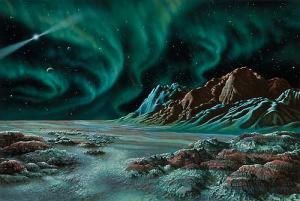If the name Alex Wolszczan (pronounced VOL-shtan) isn’t immediately familiar, it may be because we’ve become so inured to new extrasolar planet discoveries that we’ve forgotten about the first. But it was Pennsylvania State University’s Wolszczan who, in 1991, was the first to detect planets outside our Solar System, around the pulsar PSR B1257+12, an incredibly dense neutron star that is the remnant of a once massive star in the constellation Virgo some 1500 light years away.
 These were the first new planets discovered since Clyde Tombaugh’s detection of Pluto in 1930, and Wolszczan was able to learn a surprising amount about them. Using the Arecibo radio telescope in Puerto Rico, he found that two of them were roughly similar in mass to the Earth, while the other corresponded roughly to the mass of the Moon. Their spacing around the primary corresponded to that between Mercury, Venus and the Earth around our Sun.
These were the first new planets discovered since Clyde Tombaugh’s detection of Pluto in 1930, and Wolszczan was able to learn a surprising amount about them. Using the Arecibo radio telescope in Puerto Rico, he found that two of them were roughly similar in mass to the Earth, while the other corresponded roughly to the mass of the Moon. Their spacing around the primary corresponded to that between Mercury, Venus and the Earth around our Sun.
Image: An artist’s conception of one of the planets around the pulsar PSR 1257+12. Note the intense aurora, the result of the continuing bombardment of radiation from the pulsar. Copyright Lynette Cook, and used with her permission (http://extrasolar.spaceart.org)
Now from the Winter Conference on Astrophysics in Aspen comes a new discovery around the same pulsar: a fourth planet, roughly as far from the pulsar as the asteroid belt is from the Sun. Caltech’s Maciej Konacki is co-discoverer of the new planet along with Wolszczan:
“Because our observations practically rule out a possible presence of an even more distant, massive planet or planets around the pulsar, it is quite possible that the tiny fourth planet is the largest member of a cloud of interplanetary debris at the outer edge of the pulsar’s planetary system, a remnant of the original protoplanetary disk that created the three inner planets,” Wolszczan explained. The small planet, about one-fifth of the mass of Pluto, may occupy the same outer-boundary position in its planetary system as Pluto does in our solar system. “Surprisingly, the planetary system around this pulsar resembles our own solar system more than any extrasolar planetary system discovered around a Sun-like star,” Konacki said.
So how do we detect planets as small as Earth’s Moon around a star 1500 light years away? Pulsars turn out to be quite useful for detecting planetary wobbles — they pulse with a degree of accuracy known only to the finest atomic clocks. That makes detections down to asteroid size a possibility, a feat not yet possible with the stellar wobbles used by optical astronomers around more conventional main sequence stars.
This press release from PSU leaves us with an intriguing question:
The very existence of the pulsar planets may represent convincing evidence that Earth-mass planets form just as easily as do the gas giants that are known to exist around more than 5 percent of the nearby Sun-like stars. However, Wolszczan said, “the message carried by the pulsar planets may equally well be that the formation of Earth-like planets requires special conditions, making such planets a rarity. For example, there is growing evidence that a nearby supernova explosion may have played an important role in our solar system’s formation.” Future space observatories, including the Kepler and the Space Interferometry Missions, and the Terrestrial Planet Finder, will play a decisive role in making a distinction between these fundamental alternatives.
Wolszczan maintains a Pulsar Planets page at PSU with background on the first extrasolar planet detections. He presented the paper “A Pluto-Mass Body and Ionized Gas in the PSR B1257+12 Planetary System” at the Aspen conference on February 11.


Possibility of Detecting Moons of Pulsar Planets Through Time-of-Arrival Analysis
Authors: Karen M. Lewis (1), Penny D. Sackett (2), Rosemary A. Mardling (1) ((1) School of Mathematical Sciences, Monash University, (2) Research School of Astronomy and Astrophysics)
(Submitted on 28 May 2008)
Abstract: The perturbation caused by planet-moon binarity on the time-of-arrival signal of a pulsar with an orbiting planet is derived for the case in which the orbits of the moon and the planet-moon barycenter are both circular and coplanar. The signal consists of two sinusoids with frequency (2n_p – 3n_b) and (2n_p – n_b ), where n_p and n_b are the mean motions of the planet and moon around their barycenter, and the planet-moon system around the host, respectively. The amplitude of the signal is equal to the fraction sin I[9(M_p M_m)/16(M_p + M_m)^2] [r/R]^5 of the system crossing time R/c, where M_p and M_m are the the masses of the planet and moon, r is their orbital separation, R is the distance between the host pulsar and planet-moon barycenter, I is the inclination of the orbital plane of the planet, and c is the speed of light.
The analysis is applied to the case of PSR B1620-26 b, a pulsar planet, to constrain the orbital separation and mass of any possible moons. We find that a stable moon orbiting this pulsar planet could be detected, if the moon had a separation of about one fiftieth of that of the orbit of the planet around the pulsar, and a mass ratio to the planet of ~5% or larger.
Comments: 11 pages, 3 figures
Subjects: Astrophysics (astro-ph)
Cite as: arXiv:0805.4263v1 [astro-ph]
Submission history
From: Karen Lewis [view email]
[v1] Wed, 28 May 2008 06:19:23 GMT (330kb,D)
http://arxiv.org/abs/0805.4263